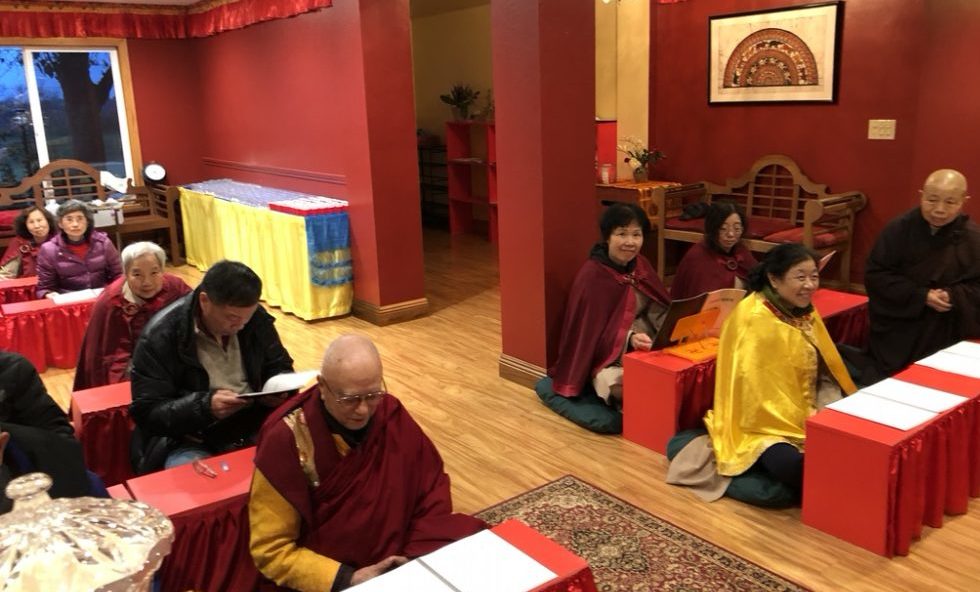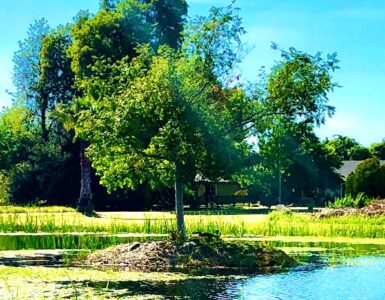
This retreat on His Holiness Dorje Chang Buddha III’s sutra Imparting the Absolute Truth through the Heart Sutra will start at the beginning and hopefully cover the first 120 pages that are devoted to understanding each of the five words in the title of the Prajna Parami-Ta Heart Sutra. We will have three dharma classes on Saturday and Sunday (February 8 and 9), to enable those who can only attend on the weekend to hear more of the sutra. We start at 7:00 pm on Friday, February 7, and hold classes at 9:00 am and 7:00 pm Monday through Friday (February 10-14). Saturday and Sunday classes will be at 9:00 am, 2:00 pm, and 7:00 pm. You are welcome to come for any or all of the classes. The afternoons during the week will be reserved for study and meditation, so we do ask you observe silence. Please let us know if you can join us for any meals so we can plan accordingly. CLICK for more.
Friday, February 7, 7:00 pm: Lesson 1–H.H. Dorje Chang Buddha III introduces the Heart Sutra and how He uses that great dharma by Avalokitesvara Bodhisattva to impart the dharma of liberation to us. This will include the historical framework for the Heart Sutra. CLICK for article on why we changed the name of the Buddha Masters text to Imparting the Absolute Truth through the Heart Sutra.
Saturday, February 8
9:00 am: Listen to recent CD recording of discourse by H.H. Dorje Chang Buddha III with English translation given at the Holy Miracles Temple in October and released on H.H. Dorje Chang Buddha III Day, January 19, 2020 titled “The Intrinsically Existing Truth of No Arising and No Ceasing in the Universe and in Human Lives Realized by the Buddha Was Not Created by the Buddha.” CLICK for more information on this discourse.
11:00 am: Lesson 2–This class will be the first of six classes that will explain the title of the sutra. It will also discuss cutting off attachment to self while still using the term “I”; how this sutra contains the essence of the 600 volumes on “prajna” or the wisdom of the Buddha; how to attain the bodies and wisdom of a Buddha; and other matters related to becoming a holy person.
2:00 pm: Lesson 3–Begins the discussion of “prajna” explaining why it is inaccurate and frivolous to translate prajna as wisdom because what we call “wisdom” includes both intelligence and craftiness while prajna is the unequaled and incomparable marvelous wisdom of a buddha. This class also explains why Monkey King Sun Wukong and Dharma Master Xuanzang’s trip to India, as told in the classic Chinese book Journey to the West, is much more than an entertaining adventure and story.
7:00 pm: Lesson 4–Continues the discussion of “prajna” introducing the three types of prajna: language, contemplative illumination, and intrinsic-reality.
Sunday, February 9
9:00 am: Lesson 5–Continues the discussion of “prajna” defining what is meant by contemplative illumination prajna and the importance of understanding the concept of “two-fold truth” or the holy and absolute truth and its conventional or relative truth–one relies on the absolute truth to become enlightened, but one attains perfect understanding through the conventional truth. This class focuses on holding the “middle view” of non-duality. It also discusses the transformation of the body into rainbow light and other dharmas.
2:00 pm: Lesson 6–Continues the discussion of “prajna” and the meaning of intrinsic-reality prajna and the karmic forces of living beings. This class also discusses the five aggregates of form, feelings, conceptualization, volition and consciousness as well as the manas and alaya consciousnesses and other important principles and methods of entering the truth and attaining enlightenment.
7:00 pm: Lesson 7–Continues the discussion of “prajna” explaining the difference between what is true or the absolute truth or Buddha-nature of a buddha that we all have and what is false or the discriminating, differentiating mind consciousness that we also have as ordinary beings. This class also explains the causes of our suffering as ordinary living beings.
Monday, February 10
9:00 am: Lesson 8–The last class on the term “prajna” discusses how to overcome the obstacles of defilement through cultivation. Explains how Bodhisattvas perfect the Six Paramitas (generosity, keeping precepts, patience and forebearance, exerting effort, meditative concentration, and prajna or true wisdom) practicing them together, excluding none of them and giving no thought to gaining merit.
7:00 pm: Lesson 9–Includes a discussion of both “parami” (literally “reaching the other shore”) and “ta” which is interpreted as “right concentration” or absolute imperturbability when all thoughts are still and gone. This is concentration that is correct and without bias. It is centered and correct, not tending to one extreme or another. One must equally apply concentration and wisdom, without emphasizing one over the other. This class will also look at some differences in inclinations of Daoist, other non-Buddhists, Arhats, Pratyeka-buddhas, etc.
Tuesday, February 11
9:00 am: Lesson 10–This important class will look at various aspects of delusion and awakening and includes stories about two well known Chinese patriarchs–Huineng and Bodhidharma. It also includes why concentration and wisdom are equal and why both must be perfected. The term “heart” from the title is also discussed.
7:00 pm: Lesson 11–Here we take the last word in the title, “sutra” and learn that sutras are the teachings spoken by the Buddhas that accord with principles and accord with the spiritual capacity of living beings.
The Heart Sutra contains the essence or gist of the 600 volumes of the Maha Prajna-Paramita Sutra. This sutra has condensed the essence of non-duality by which the Buddhas accomplished liberation. The reality of non-duality is the reality state of prajna-wisdom illumination. Why is this reality called non-duality? It is because there is no attachment to existence, and there is no attachment to non-existence.
Wednesday, February 12
9:00 am: Lesson 12–Continuing to discuss the term “sutra” this class provides an introduction to many concepts that will be developed in more detail in later classes like “samadhi,” just who Avalokitesvara or Kuan Yin Bodhisattva is, the importance of “ta,” and an historical account of the seventh century Chinese Dharma Master Xuanzang, whose translation of the Prajna Paramita Heart Sutra we use.
7:00 pm: Lesson 13–This section continues with more background on the Sixth Patriarch of Chen or Zen, Huineng, and more about the Consciousness-Only or Faxiang School founded by Dharma Master Xuanzang.
Thursday, February 13
9:00 am: Today we will probably be able to start the second part of this sutra where the actual text of the Prajna Paramita Heart Sutra is used to impart the absolute truth. Those attending can elect to continue with more new material or go back and reread earlier parts of the sutra.
Lesson 14–If we continue we will learn more about Avalokitesvara Bodhisatva, the Diamond Sutra, the Yogacarabhumi Sastra, and practices of the Pure Land School.
7:00 pm: Lesson 15–This class discusses the Vajra Yoga Perfection Dharma of Avalokitesvara Bodhisattva and looks at the conduct of a number of Bodhisattvas to help us understand what a Bodhisattva does and what we need to do to become one.
Friday, February 14
9:00 am: Lesson 16–-Now we start the exposition of the dharma itself, studying the passage “…when practicing deeply the prajna-paramita…” investigating “behavior” and how our three karmas of body, speech, and mind should correspond to the dharma taught by the world-honored one. Various methods of practice are discussed.
7:00 pm: Lesson 17–This continues with other meditation methods discussed along with the dangers of intellectual frivolity or using words or concepts to cover the meaning of reality.
This is an ambitious agenda. Some may opt to spend more time in meditation and if that is the case we will adjust the program accordingly. Understanding this material is very important and we recognize that different people have different capacities and methods of gaining understanding. For those students who can read the text in the original Chinese, we urge you to bring your text and follow the English reading. Again, I must stress this is still a preliminary translation so we know there are errors and omissions. Most of us will need to read and study this amazing text many times.




Add comment